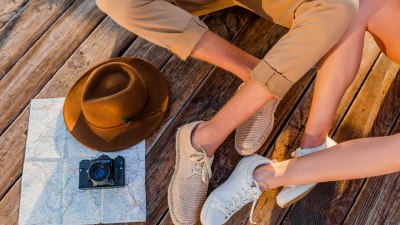What Your Travel Shoes Say About Your Ability to Survive Local Weather
Discover how your choice of travel shoes reflects your preparedness for local weather conditions.

Image by marymarkevich on Freepik
Travel shoes can speak volumes about a traveler’s readiness to adapt to diverse climates and terrains. Choosing the right footwear is not just about style; it is about survival, comfort, and embracing the local environment. In this article, we will explore the crucial aspects of travel shoes and how they relate to an individual’s ability to withstand local weather conditions.
The Importance of Choosing the Right Travel Footwear
Footwear is often underestimated when planning travels, yet it plays a vital role in the overall experience. The right pair of shoes can prevent injuries, provide comfort during extended walking, and adapt to varying weather conditions, ensuring that travelers are not uncomfortable or ill-prepared. In areas with unpredictable weather, selecting shoes designed for durability and versatility can significantly impact your journey.
Shoes for Different Weather Conditions
Traveling involves navigating through different weather scenarios, and your footwear should be capable of handling the environmental challenges you may face:
1. Rainy Weather
When it rains, having waterproof shoes is essential. Leather or synthetic shoes treated for water resistance can keep your feet dry and minimize discomfort. Shoes with good traction are crucial for slippery surfaces, as they provide stability and prevent falling. Opting for waterproof footwear shows you're prepared for unexpected downpours and the resulting puddles.
2. Hot Weather
Keeping feet cool during hot weather is vital. Breathable and lightweight shoes, such as sandals or mesh sneakers, allow for proper ventilation. Shoes with moisture-wicking properties can help prevent blisters and discomfort caused by sweat. Choosing appropriate shoes can reflect an awareness of local climate and a willingness to prioritize comfort in varying temperatures.
3. Cold and Snowy Weather
For cold climates, insulated and waterproof boots are necessary to keep feet warm and dry. Look for options with non-slip soles to navigate icy conditions effectively. Wearing shoes designed explicitly for snow will prevent frostbite and ensure safety on slippery surfaces. This demonstrates a serious commitment to staying safe and comfortable despite winter conditions.
4. Rough Terrain
Hiking shoes or trail runners are crucial for navigating rocky or uneven terrain. Shoes with ankle support and a sturdy grip are essential for preventing injuries while exploring nature. Having the right footwear for adventure shows preparedness and enhances the ability to enjoy and survive challenging environments.
Regional Differences in Footwear Expectations
Consider regional customs and weather expectations when selecting travel shoes. For example, in tropical regions, locals often wear sandals or flip-flops due to the heat. Conversely, in colder climates, you might find locals using insulated boots. Your travel shoes align with or disrupt these local norms, perhaps indicating your adaptability to the environment.
The Influence of Fashion
Your choice of travel shoes can also reflect personal style and cultural awareness. Fashionable shoes that are also functional can create a positive impression among locals. Conversely, wearing inappropriate or overly formal shoes can signify a lack of understanding of the local culture or climate. Striking a balance between style and practicality can enhance cross-cultural interactions.
Notable Travel Shoe Brands
Different brands specialize in creating shoes tailored to specific climates and terrains. Brands like Merrell, Salomon, and Columbia are known for their durable outdoor footwear, while Teva and Crocs cater to warm-weather travel. Investing in quality footwear that aligns with your travel plans is essential for both performance and comfort.
Considerations for Special Needs
Travelers with specific needs, such as those with foot pain or conditions like plantar fasciitis, should prioritize comfort over all. Shoes with arch support, cushioning, and adjustability can make a significant difference in overall comfort and the ability to enjoy travel. Flexibility in shoe selection can showcase your adaptability to personal requirements while remaining considerate of local conditions.
Adapting to Unexpected Weather Changes
Weather can be unpredictable, and travelers may face unexpected changes during their journey. Carrying an extra pair of versatile shoes can be helpful to adapt to changing weather conditions efficiently. For instance, a lightweight waterproof cover can protect everyday shoes from rain, allowing continued exploration without compromise.
Traveling with Minimal Luggage
For those who opt to travel with minimal luggage, selecting versatile shoes becomes paramount. A single pair of shoes that works for various conditions and looks decent can significantly reduce packing and logistical hassles. Many shoes now boast designs that encapsulate both style and functionality, allowing for an efficient travel experience.
The Ethics of Travel Footwear
As sustainability becomes a pressing global concern, considering the ethics behind footwear production is essential. Opting for brands that prioritize ethical labor practices and sustainable materials can reflect conscientious travel choices. Your shoes can signify a commitment to responsible travel and a desire to make choices that align with principles of environmental stewardship.
Shoes as a Reflection of Travel Preparedness
In conclusion, your travel shoes tell a compelling story about your ability to adapt to local weather conditions. Investing in thoughtful footwear decisions can enhance your travel experience, ensuring comfort, safety, and cultural respect. Next time you pack for a journey, remember that the choices you make with your footwear say more about your preparedness than you might realize. Embrace the journey, weather the conditions, and walk with confidence in the right shoes!











